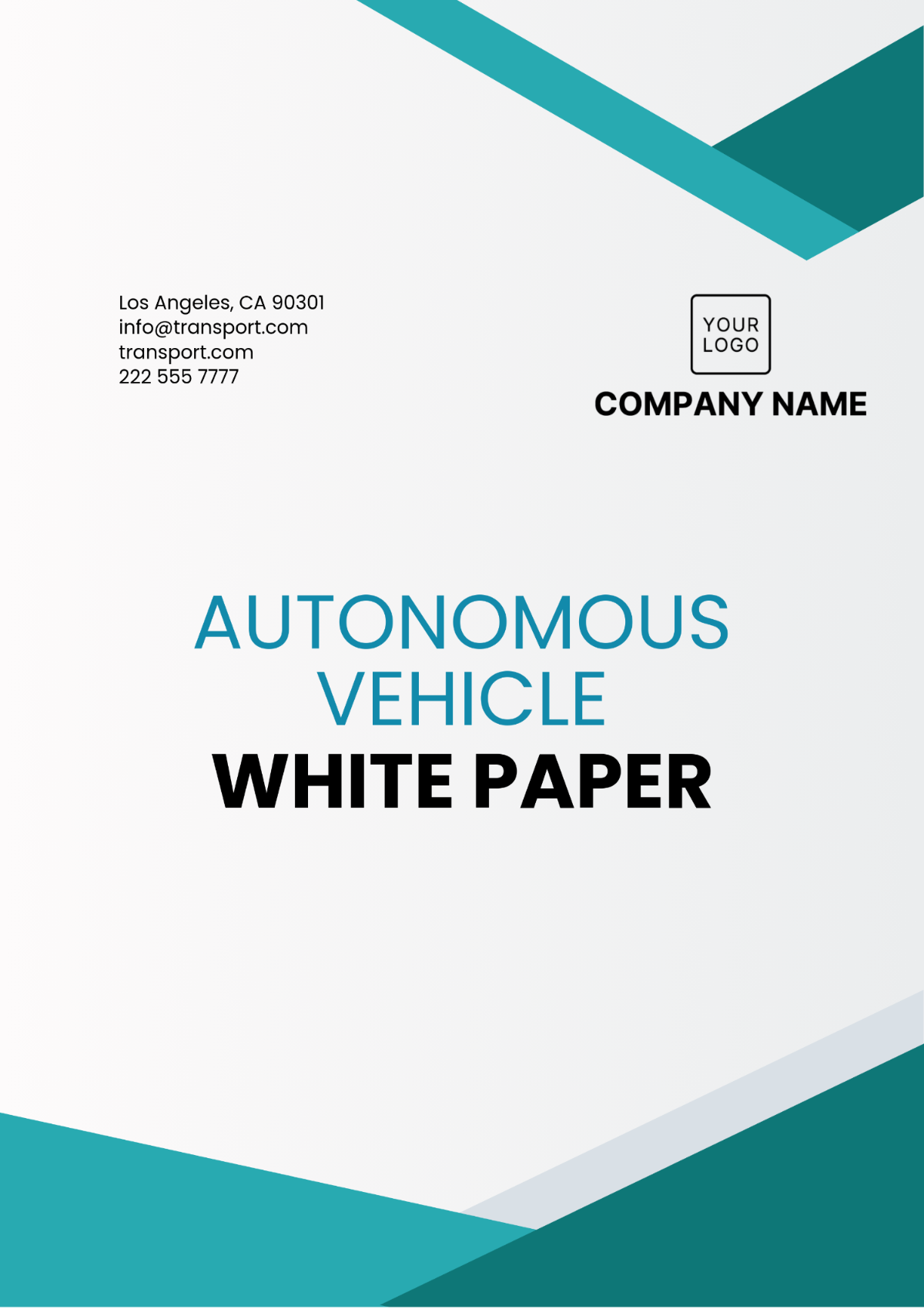Free Autonomous Vehicle White Paper

Prepared by: [YOUR NAME]
I. Executive Summary
Autonomous vehicles, powered by cutting-edge technology, are poised to revolutionize transportation as we know it. This white paper offers a comprehensive exploration of autonomous vehicle technology, covering its benefits, challenges, regulatory landscape, market dynamics, and stakeholder perspectives.
II. Introduction

The emergence of autonomous vehicles represents a transformative shift in mobility, promising safer, more efficient transportation solutions. This section introduces the purpose of the white paper and outlines its structure for a detailed examination of autonomous vehicle innovation.
III. Understanding Autonomous Vehicle Technology
A. Definition of Autonomous Vehicles
Autonomous vehicles, also known as self-driving cars, are vehicles equipped with advanced sensors, artificial intelligence algorithms, and connectivity features to navigate and operate without human intervention.
B. Levels of Automation
The SAE International's classification system categorizes autonomous vehicles into six levels, ranging from Level 0 (no automation) to Level 5 (full automation), each representing varying degrees of autonomy in driving tasks.
C. Key Technologies
Autonomous driving technology integrates a range of technologies, including LiDAR, radar, cameras, GPS, and onboard computers, to perceive the environment, analyze data, and make driving decisions in real time.
IV. Benefits and Risks of Autonomous Vehicles
A. Potential Benefits
Safety enhancement: Autonomous vehicles have the potential to reduce traffic accidents caused by human error, potentially saving thousands of lives each year.
Improved mobility: Self-driving cars can provide accessible transportation options for individuals with disabilities and seniors, enhancing mobility and independence.
Environmental sustainability: Autonomous technology can optimize driving patterns, reduce congestion, and promote the adoption of electric vehicles, contributing to a greener, more sustainable transportation ecosystem.
B. Potential Risks and Challenges

Cybersecurity vulnerabilities: The connectivity of autonomous vehicles raises concerns about cybersecurity threats, including hacking, data breaches, and unauthorized access.
Ethical considerations: Autonomous vehicles face ethical dilemmas, such as decision-making in life-threatening situations, raising questions about liability and moral responsibility.
Regulatory complexity: Developing regulatory frameworks for autonomous vehicles presents challenges related to safety standards, liability, insurance, and privacy protection.
V. Regulatory Landscape
A. Current Regulations
In the United States, the National Highway Traffic Safety Administration (NHTSA) provides guidelines and regulations for autonomous vehicle testing and deployment, while individual states establish their own rules.
Internationally, countries like Germany and Japan have implemented regulatory frameworks to govern autonomous vehicle development and operation.
B. Future Regulatory Outlook
Anticipated regulatory developments include updates to safety standards, liability frameworks, and data privacy regulations to address emerging challenges and ensure the safe and responsible integration of autonomous vehicles into society.
VI. Market Dynamics
A. Market Overview
The global autonomous vehicle market is expected to grow exponentially, driven by technological advancements, changing consumer preferences, and investment from automotive manufacturers and technology companies.
Key players in the autonomous vehicle industry include Tesla, Waymo, General Motors, and traditional automakers like Toyota and Ford.
B. Market Trends
Title: " Generative AI in Automotive Market Share, By Region, 2023(%)"
Emerging trends in autonomous vehicles include the development of autonomous ride-hailing services, last-mile delivery solutions, and partnerships between automotive and technology companies to accelerate innovation and deployment.
VII. Stakeholder Perspectives
A. Industry Stakeholders
Automotive manufacturers are investing heavily in research and development to bring autonomous vehicles to market, collaborating with technology companies and startups to accelerate innovation and commercialization efforts.
Technology companies like Waymo and Uber are leading the development of self-driving technology, leveraging their expertise in artificial intelligence and robotics to create next-generation mobility solutions.
B. Policymakers and Regulators
Policymakers and regulators play a crucial role in shaping the regulatory landscape for autonomous vehicles, balancing safety, innovation, and public trust in developing policies and regulations that govern testing, deployment, and operation.
Collaboration between government agencies, industry stakeholders, and advocacy groups is essential to establish clear and consistent regulatory frameworks that promote innovation while ensuring safety and accountability.
C. Investors and Financial Analysts
Investors and financial analysts are closely monitoring the autonomous vehicle market, identifying investment opportunities, assessing market trends and dynamics, and evaluating the financial performance and growth potential of companies involved in autonomous technology and mobility services.
VIII. Conclusion
In conclusion, autonomous vehicles hold the promise to revolutionize transportation, offering safer, more accessible, and sustainable mobility solutions. However, realizing this vision requires addressing the complex challenges and uncertainties surrounding autonomous technology, including regulatory, ethical, and societal considerations. By fostering collaboration and innovation, we can harness the full potential of autonomous vehicles to create a safer, more efficient, and more equitable transportation future.
IX. References
National Highway Traffic Safety Administration. (2020). In CQ Press eBooks (pp. 933–938). https://doi.org/10.4135/9781544377230.n133
Roos, F., Bechter, J., Knill, C., Schweizer, B., & Waldschmidt, C. (2019). Radar sensors for Autonomous Driving: modulation schemes and interference mitigation. IEEE Microwave Magazine, 20(9), 58–72. https://doi.org/10.1109/mmm.2019.2922120
Fagnant, D. J., & Kockelman, K. M. (2015). Preparing a nation for autonomous vehicles: opportunities, barriers and policy recommendations. Transportation Research. Part a, Policy and Practice, 77, 167–181. https://doi.org/10.1016/j.tra.2015.04.003
- 100% Customizable, free editor
- Access 1 Million+ Templates, photo’s & graphics
- Download or share as a template
- Click and replace photos, graphics, text, backgrounds
- Resize, crop, AI write & more
- Access advanced editor
Discover the ultimate resource for crafting your Autonomous Vehicle White Paper with Template.net. Our editable and customizable template empowers you to create a comprehensive document tailored to your needs. Effortlessly edit in our Ai Editor Tool, ensuring seamless customization and professional presentation for all stakeholders. Unlock your white paper's potential today.





























